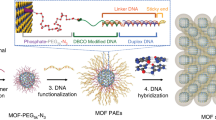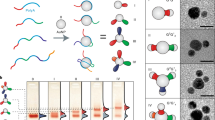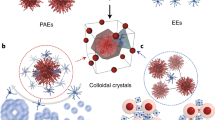Abstract
It was first shown1,2 more than ten years ago that DNA oligonucleotides can be attached to gold nanoparticles rationally to direct the formation of larger assemblies. Since then, oligonucleotide-functionalized nanoparticles have been developed into powerful diagnostic tools3,4 for nucleic acids and proteins, and into intracellular probes5 and gene regulators6. In contrast, the conceptually simple yet powerful idea that functionalized nanoparticles might serve as basic building blocks that can be rationally assembled through programmable base-pairing interactions into highly ordered macroscopic materials remains poorly developed. So far, the approach has mainly resulted in polymerization, with modest control over the placement of, the periodicity in, and the distance between particles within the assembled material. That is, most of the materials obtained thus far are best classified as amorphous polymers7,8,9,10,11,12,13,14,15,16, although a few examples of colloidal crystal formation exist8,16. Here, we demonstrate that DNA can be used to control the crystallization of nanoparticle–oligonucleotide conjugates to the extent that different DNA sequences guide the assembly of the same type of inorganic nanoparticle into different crystalline states. We show that the choice of DNA sequences attached to the nanoparticle building blocks, the DNA linking molecules and the absence or presence of a non-bonding single-base flexor can be adjusted so that gold nanoparticles assemble into micrometre-sized face-centred-cubic or body-centred-cubic crystal structures. Our findings thus clearly demonstrate that synthetically programmable colloidal crystallization is possible, and that a single-component system can be directed to form different structures.
This is a preview of subscription content, access via your institution
Access options
Subscribe to this journal
Receive 51 print issues and online access
$199.00 per year
only $3.90 per issue
Buy this article
- Purchase on Springer Link
- Instant access to full article PDF
Prices may be subject to local taxes which are calculated during checkout




Similar content being viewed by others
References
Mirkin, C. A., Letsinger, R. L., Mucic, R. C. & Storhoff, J. J. A DNA-based method for rationally assembling nanoparticles into macroscopic materials. Nature 382, 607–609 (1996)
Alivisatos, A. P. et al. Organization of ‘nanocrystal molecules’ using DNA. Nature 382, 609–611 (1996)
Rosi, N. L. & Mirkin, C. A. Nanostructures in biodiagnostics. Chem. Rev. 105, 1547–1562 (2005)
Ozin, G. A. & Arsenault, A. C. Nanochemistry: A Chemical Approach to Nanomaterials (Royal Society of Chemistry, Cambridge, UK, 2005)
Seferos, D. S., Giljohann, D. A., Hill, H. D., Prigodich, A. E. & Mirkin, C. A. Nano-flares: Probes for transfection and mRNA detection in living cells. J. Am. Chem. Soc. 129, 15477–15479 (2007)
Rosi, N. L. et al. Oligonucleotide-modified gold nanoparticles for intracellular gene regulation. Science 312, 1027–1030 (2006)
Park, S. J., Lazarides, A. A., Storhoff, J. J., Pesce, L. & Mirkin, C. A. The structural characterization of oligonucleotide-modified gold nanoparticle networks formed by DNA hybridization. J. Phys. Chem. B 108, 12375–12380 (2004)
Biancaniello, P. L., Kim, A. J. & Crocker, J. C. Colloidal interactions and self-assembly using DNA hybridization. Phys. Rev. Lett. 94, 058302 (2005)
Park, S. J., Lazarides, A. A., Mirkin, C. A. & Letsinger, R. L. Directed assembly of periodic materials from protein and oligonucleotide-modified nanoparticle building blocks. Angew. Chem. Int. Edn 40, 2909–2912 (2001)
Park, S. Y. & Stroud, D. Theory of melting and the optical properties of gold/DNA nanocomposites. Phys. Rev. B 67, 212202 (2003)
Park, S. Y. & Stroud, D. Structure formation, melting, and optical properties of gold/DNA nanocomposites: Effects of relaxation time. Phys. Rev. B 68, 224201 (2003)
Park, S. Y., Lee, J. S., Georganopoulou, D., Mirkin, C. A. & Schatz, G. C. Structures of DNA-linked nanoparticle aggregates. J. Phys. Chem. B 110, 12673–12681 (2006)
Velev, O. D. Self-assembly of unusual nanoparticle crystals. Science 312, 376–377 (2006)
Strable, E., Johnson, J. E. & Finn, M. G. Natural nanochemical building blocks: icosahedral virus particles organized by attached oligonucleotides. Nano Lett. 4, 1385–1389 (2004)
Nykypanchuk, D., Maye, M. M., der Lelie, D. & Gang, O. DNA-based approach for interparticle interaction control. Langmuir 23, 6305–6314 (2007)
Kim, A. J., Biancaniello, P. L. & Crocker, J. C. Engineering DNA-mediated colloidal crystallization. Langmuir 22, 1991–2001 (2001)
Hurst, S. J., Lytton-Jean, A. K. R. & Mirkin, C. A. Maximizing DNA loading on a range of gold nanoparticle sizes. Anal. Chem. 78, 8313–8318 (2006)
Huo, F., Lytton-Jean, A. K. R. & Mirkin, C. A. Asymmetric functionalization of nanoparticles based on thermally addressable DNA interconnects. Adv. Mat. 18, 2304–2306 (2006)
Redl, F. X., Cho, K. S., Murray, C. B. & O'Brien, S. Three-dimensional binary superlattices of magnetic nanocrystals and semiconductor quantum dots. Nature 423, 968–971 (2003)
Leunissen, M. E. et al. Ionic colloidal crystals of oppositely charged particles. Nature 437, 235–240 (2005)
Bartlett, P. & Campbell, A. I. Three-dimensional binary superlattices of oppositely charged colloids. Phys. Rev. Lett. 95, 128302 (2005)
Shevchenko, E. V., Talapin, D. V., Kotov, N. A., O’Brien, S. & Murray, C. B. Structural diversity in binary nanoparticle superlattices. Nature 439, 55–59 (2006)
Kalsin, A. M. et al. Electrostatic self-assembly of binary nanoparticle crystals with a diamond-like lattice. Science 312, 420–424 (2006)
Donev, A., Torquato, S., Stillinger, F. H. & Connelly, R. A linear programming algorithm to test for jamming in hard-sphere packings. J. Comput. Phys. 197, 139–166 (2004)
Cullity, B. D. Elements of X-Ray Diffraction (Addison-Wesley, Reading, Massachusetts, 1978)
Frenkel, D. Colloidal crystals: plenty of room at the top. Nature Mater. 5, 85–86 (2006)
Kiely, C. J., Fink, J., Brust, M., Bethell, D. & Schiffrin, D. J. Spontaneous ordering of bimodal ensembles of nanoscopic gold clusters. Nature 396, 444–446 (1998)
Hoogerbrugge, P. J. & Koelman, J. M. V. A. Simulating microscopic hydrodynamic phenomena with dissipative particle dynamics. Europhys. Lett. 19, 155–160 (1992)
Español, P. & Warren, P. Statistical mechanics of dissipative particle dynamics. Europhys. Lett. 30, 191–196 (1995)
Xu, X.-Y., Rosi, N. L., Wang, Y., Huo, F. & Mirkin, C. A. Asymmetric functionalization of gold nanoparticles with oligonucleotides. J. Am. Chem. Soc. 128, 9286–9287 (2006)
Acknowledgements
C.A.M. acknowledges the AFOSR and NSF for support of this work. C.A.M is also grateful for a NIH Director’s Pioneer Award. S.Y.P. and G.C.S. were supported by the NSF. S.Y.P. and G.C.S. thank S. Torquato for providing numerical model output and S. Ryu for discussions. We thank S. Seifert for help with the SAXS set-up. We thank the Argonne National Laboratory for the use of the APS, supported by the US Department of Energy, Office of Science, Office of Basic Energy Sciences.
Author Contributions C.A.M. was the originator of the concept of programmable colloidal crystallization with DNA. A.K.R.L.-J. and C.A.M were responsible for the synthetic components of the project and sequence design. S.Y.P. and G.C.S. were responsible for the theoretical components of the project. S.W. designed the SAXS set-up. S.Y.P., A.K.R.L.-J. and B.L. designed and performed SAXS experiments. S.Y.P. and B.L. analysed the SAXS data. All authors contributed to the writing of the manuscript.
Author information
Authors and Affiliations
Corresponding author
Supplementary information
Supplementary Information
The file contains Supplementary Notes and Supplementary Figures S1-S5 with Legends. This file was replaced on 4 February 2008. (PDF 363 kb)
Rights and permissions
About this article
Cite this article
Park, S., Lytton-Jean, A., Lee, B. et al. DNA-programmable nanoparticle crystallization. Nature 451, 553–556 (2008). https://doi.org/10.1038/nature06508
Received:
Accepted:
Issue Date:
DOI: https://doi.org/10.1038/nature06508
This article is cited by
-
Research progress of multi-enzyme complexes based on the design of scaffold protein
Bioresources and Bioprocessing (2023)
-
Synthesis of branched silica nanotrees using a nanodroplet sequential fusion strategy
Nature Synthesis (2023)
-
Crystallization of binary nanocrystal superlattices and the relevance of short-range attraction
Nature Synthesis (2023)
-
Preparation, applications, and challenges of functional DNA nanomaterials
Nano Research (2023)
-
Spherical Packing Superlattices in Self-Assembly of Homogenous Soft Matter: Progresses and Potentials
Chinese Journal of Polymer Science (2023)
Comments
By submitting a comment you agree to abide by our Terms and Community Guidelines. If you find something abusive or that does not comply with our terms or guidelines please flag it as inappropriate.



